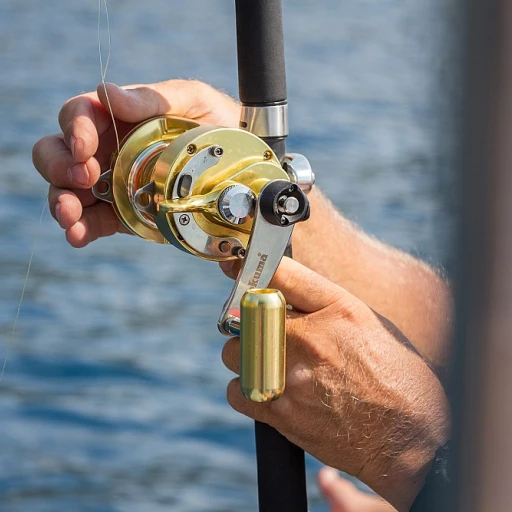The allure of the deep sea: why we are fascinated by rare deep sea creatures
The captivating depths of Earth's oceans
Ever wonder what lies thousands of feet deep in the ocean? It's not just the vast emptiness staring at you; it's the intricate dance of life, shrouded in mystery, that pulls us in. The rare deep sea creatures that inhabit these depths capture our imagination with their bizarre and beautiful forms. Imagine the first intrepid explorers using primitive technology to catch an elusive glimpse of these elusive beings. Their discoveries would forever change our understanding of life on Earth.
Endless curiosity: what lies beneath the ocean's surface?
The allure of the deep sea often stems from a mix of thrill and fear. The reality is that we know more about the surface of the moon than we do about the ocean floor, strewn with volcanic vents and harboring some of Earth's most phenomenal creatures. The NOAA states that over 80% of the ocean is unmapped, unobserved, and unexplored. It's a mystery that keeps scientists and enthusiasts coming back for more. Each visit to the depths reveals new species, like the awe-inspiring goblin shark and the mesmerizing vampire squid.
Unraveling the unknown
Our fascination goes beyond mere curiosity. The creatures of the deep ocean are like a living episode of a nature documentary but with plot twists we never see coming. Their astounding adaptations, such as bioluminescence and otherworldly structures, spark endless questions and theories. The vampire squid, for instance, doesn't just look cool—it's got a whole library of survival strategies up its sleeve, surviving where light cannot penetrate. Scientists like Dr. Bruce Robison from MBARI reveal that “each expedition is full of surprises and new questions about how life can thrive in such extreme conditions” (source: National Marine Sanctuaries).
A journey to the depths: technology and techniques
Advances in technology and techniques for probing the abyss
Exploring the deep sea, with its mysterious deep sea creatures, requires specialized technology and techniques. The harsh environment entices both scientists and adventurous fishermen alike, challenging them to innovate and adapt continuously.
The evolution of deep-sea submersibles
Deep-sea submersibles have radically changed our understanding of life in the ocean's depths. In the 1960s, the bathyscaphe Trieste made history by descending nearly 36,000 feet into the Mariana Trench. Fast forward decades, and modern submersibles like ALVIN and Japan's Shinkai 6500 can dive to astonishing depths, equipped with advanced imaging and sampling tools.
The MBARI (Monterey Bay Aquarium Research Institute) has been at the forefront of these developments, deploying remotely operated vehicles (ROVs) and autonomous underwater vehicles (AUVs) that venture into previously inaccessible deep-sea realms.
Remote sensing technologies
Modern sonar mapping and satellite tracking are indispensable tools for deep-sea exploration. Multibeam sonar systems provide intricate digital renderings of the ocean floor, allowing scientists to pinpoint diverse habitats teeming with marine life. Meanwhile, satellite tagging of species like the Pacific footballfish offers new insights into their migration patterns and behaviors.
Bioluminescence detection
Bioluminescent creatures are a hallmark of the deep sea. Devices like the Low-Light Imager, crafted by NOAA, capture the soft glows emitted by animals like the vampire squid. This technology reveals how these creatures use light to communicate, hunt prey, and evade predators, painting a vivid picture of life in the deep's inky blackness.
Challenges for deep-sea explorers
Exploring the ocean and its depths isn’t without its headaches. The extreme pressure and cold necessitate robust, high-endurance equipment, often making these ventures costly. Researchers juggle the need for precise instruments to withstand the intense conditions with budget limitations, frequently relying on grants and institutional funding.
Furthermore, despite technological leaps, there's still plenty we don't know. As we continue to probe the abyss, scientists and engineers must creatively overcome these barriers.
For those inspired to explore the deep blue themselves, mastering deep sea fishing techniques in unfathomable depths can offer a taste of the ocean's secrets, even if just on a fishing trip.
Meet the residents: top rare deep sea creatures
The enigmatic goblin shark: a living fossil
The goblin shark is something straight out of a prehistoric nightmare. Found primarily in the waters around Japan, this creature is often dubbed a 'living fossil' due to its lineage that traces back roughly 125 million years. The goblin shark's long, flattened snout and extendable jaws make it look like it belongs in a prehistoric exhibit rather than the deep ocean.
The goblin shark can inhabit depths of about 4,265 feet below the ocean surface, justifying its inclusion in the roster of rare deep sea creatures. Despite being detected occasionally, much of its lifestyle remains a mystery due to the rarity of encounters. According to a study published in the Journal of Fish Biology, goblin sharks grow up to 12.6 feet in length (source).
Luminous residents: the vampire squid and bioluminescence
If the goblin shark sounds terrifying, let your imagination swim over to the vampire squid. This peculiar sea creature measures about one foot in length and roams the oxygen minimum zone, around 3,000 feet deep. Unlike its name, the vampire squid is a gentle detritivore, feasting on marine snow—tiny particles of dead organisms.
The striking feature of the vampire squid is its use of bioluminescence. Unlike fish that employ strong and consistent light, the vampire squid uses gentle, sporadic glows to throw off predators. According to NOAA, these creatures light up thanks to photophores on their arms and fins, making them standout residents of this mysterious world.
Giant squid: the ultimate titan
No discussion about rare deep sea creatures would be complete without mentioning the giant squid. Found in the deep waters of the North Atlantic, especially near Newfoundland, the giant squid is one of the most elusive creatures known to marine science. These giants can grow up to 43 feet long. Their extremely large eyes, around 10 inches in diameter, help them survive and hunt in the pitch-dark ocean depths.
Recent studies by the Marine Biological Association of the United Kingdom employ sophisticated ROVs (Remotely Operated Vehicles) to capture rare images and videos of the giant squid in their natural habitats (source), yet much about its behavior and lifestyle remains shrouded in enigma.
Dumbo octopus: the adorable abyss dweller
Contrasting the horror-like images of other deep sea creatures, the dumbo octopus brings a touch of cuteness to the deep sea. Named for its ear-like fins, reminiscent of Disney's Dumbo, this sea creature typically resides at depths of 9,800 to 13,000 feet. Their unique method of propulsion involves flapping their fins like wings, earning them their charming nickname.
Despite their cute appearance, these octopuses are highly adept hunters. They feed primarily on crustaceans and copepods. The Monterey Bay Aquarium Research Institute (MBARI) has documented instances of dumbo octopuses being found at depths up to 23,000 feet, which highlights their versatility and adaptability (source).
Lights in the dark: bioluminescence in the deep sea
Bioluminescent beauties
Nestled in the dark abyss of our oceans, bioluminescent creatures shine like twisted, otherworldly stars. It's a phenomenon that has captivated scientists and the public alike. Practically, about 76% of deep-sea animals produce light in one form or another (NOAA).
For instance, the vampire squid (Vampyroteuthis infernalis) uses its blue and green lights, not only to attract prey but to confuse predators. Its photophores, the light-producing organs, can flash like a tiny underwater disco. It’s fascinating to think that a creature living thousands of feet from the ocean surface glows in the dark like that.
The glowing fish
The deep sea anglerfish is another stunning example. Living up to 16,400 feet below the surface, its bioluminescent lure dangles in front of its mouth, attracting prey in the pitch-black waters. According to a study published in the journal Current Biology, these lures contain symbiotic bacteria that produce light, a remarkable case of nature's teamwork. It’s like having living bait attached to your forehead - talk about an edge in the hunt for food!
Communication and camouflage
But not all sea creatures use light solely to catch or confuse prey. Some, such as the deep sea hatchetfish, use bioluminescence for camouflage. Scientists at the Monterey Bay Aquarium Research Institute (MBARI) have documented that the fish’s 'counter-illumination' breaks up its silhouette, helping it disappear in the sparse light filtering down from above. It's pretty much the underwater version of an invisibility cloak, and it illustrates how adaptations can be the key to survival in harsh environments.
Nature's spotlight
Lastly, let's not forget the beautiful sea creatures like the common siphonophore. These translucent, string-like creatures can grow hundreds of feet long and often bioluminesce in a rainbow of colors. Such remarkable adaptations prompt constant amazement and curiosity. Imagine living in an environment so dark, yet so elegantly lit by its residents.
Giant shadows: the immense creatures of the deep
Giants from the depths
Imagine plunging into the abyss and coming face-to-face with creatures that seem to belong in a fantasy novel. One such behemoth is the giant squid. These elusive giants can grow to an astonishing 43 feet (13 meters) in length! Scientists are still unraveling their mysteries, but they are believed to inhabit depths ranging from 980 to 3,280 feet (300 to 1,000 meters).
Giant squids aren't the only wonders lurking in the ocean depths. The vampire squid has captivated researchers with its ghoulish appearance and unique adaptations. Contrary to its name, this intriguing creature is more scavenger than predator, feasting on marine detritus and particulate matter. The vampire squid is typically found at depths of 2,000 to 3,000 feet (600 to 900 meters).
Myths come to life: the frilled shark
The frilled shark (Chlamydoselachus anguineus) might just be the closest thing we have to real-life sea monsters. Often referred to as a 'living fossil', this shark retains primitive features dating back to the Cretaceous period. It's found in patches around the Atlantic and Pacific oceans, typically between 390 and 4,200 feet (120 to 1,280 meters) deep.
According to marine biologist David A. Ebert, a leading expert on deep-sea sharks, the frilled shark's unique morphology makes it distinct among its peers. With its eel-like body and rows of needle-sharp teeth, this predator captures its prey with a swift, snake-like strike.
The behemoth of all: the giant siphonophore
Perhaps one of the most extraordinary sights in the deep is the giant siphonophore. These colonial organisms can reach astonishing lengths, with some specimens measuring up to 130 feet (40 meters). The siphonophore appears as a single entity but is actually a collection of specialized zooids, each performing different functions vital for survival. A notable observation was made by the Monterey Bay Aquarium Research Institute (MBARI) in 2020, revealing a 150-foot siphonophore in the Java Trench.
Legendary appearances: the goblin shark
The goblin shark (Mitsukurina owstoni) is another resident of the deep that defies conventional appearances. With its elongated snout and protrusible jaws, the goblin shark looks straight out of a sci-fi movie. These sharks are usually captured in the waters around Japan, but sightings have occurred globally, from the Gulf of Mexico to the coasts of Australia and New Zealand. Marine researchers estimate these sharks inhabit depths ranging from 330 to 4,290 feet (100 to 1,300 meters).
MBARI’s Dr. Steven Haddock, a renowned expert on deep-sea creatures, has emphasized that studying these unusual animals helps unlock the secrets of our planet's most mysterious environments.
Case study: the pacific footballfish
An encounter with a pacific footballfish (Himantolophus sagamius) is a rare event. This species is named for its rounded appearance and bioluminescent lure, used to attract unsuspecting prey in the pitch-black depths. A notable incident occurred in 2021 when a dead specimen washed ashore on the beaches of North California, caught the eyes of local and international scientists alike. Generally, this species is found between 2,000 to 3,300 feet (600 to 1,000 meters) deep in the Pacific Ocean.
Giant marauders of the deep: the gulper eel
The gulper eel (Eurypharynx pelecanoides), known for its massive, gaping mouth, has long fascinated marine biologists. This unusual predator can grow up to 6 feet in length and resides at depths of 1,600 to 10,000 feet (500 to 3,000 meters). With its expandable jaws, the gulper eel can devour prey nearly its own size, making it a formidable hunter in the twilight zone of the ocean.
Survival of the fittest: adaptations to the deep sea environment
The ability to withstand immense pressure
Imagine diving thousands of feet beneath the ocean's surface, where the weight of the water above you piles up, creating pressure that would crush any ordinary terrestrial creature. But deep sea animals have adapted ingeniously to this harsh reality. Take the vampire squid (Vampyroteuthis infernalis), for instance. This elusive creature, found at depths ranging from 2,000 to 3,000 feet, has a unique gelatinous body that can withstand extreme pressures and temperatures, allowing it to inhabit such challenging environments (NOAA Ocean Exploration).
Feeding in the dark
In the pitch-black deep, finding food requires specialized adaptations. Many deep sea creatures have evolved methods to hunt and consume prey in complete darkness. The eerie anglerfish, for example, uses bioluminescent lures to attract unsuspecting victims right into its gaping maw. This is a critical survival strategy since food is scarce at such profound depths. Research from the Monterey Bay Aquarium Research Institute (MBARI) shows that anglerfish have adapted to be energy-efficient hunters, conserving energy for when prey comes within striking distance.
Reproducing under extreme conditions
One of the most astonishing adaptations of deep sea creatures is their ability to reproduce in an environment where light is nonexistent, and mates can be exceedingly rare. The goblin shark (Mitsukurina owstoni), known for its terrifying appearance, has been observed using internal fertilization. This method ensures that their offspring have a better chance of survival in the depths where they are born (NOAA).
Energy efficiency and slow metabolism
Survival in the deep sea often means surviving on very little. To cope with the scarcity of food, many deep sea species have developed slow metabolisms. The gulper eel (Eurypharynx pelecanoides), for example, can go for days, even weeks, without feeding. This adaptation helps them conserve energy in an environment where every meal is precious (Smithsonian Ocean).
Bioluminescence and camouflage
Bioluminescence not only assists in hunting but is also a survival mechanism against predators. The deep sea hatchetfish (Argyropelecus spp.) uses counter-illumination to blend in with the faint, filtered light from above, making it nearly invisible to predators below (Nature). As a result, this form of bioluminescent adaptation isn't just a neat glow in the darkness; it's a lifeline.
Highly developed sensory organs
The lack of light has led many deep sea creatures to develop extraordinary sensory organs. For instance, the frilled shark (Chlamydoselachus anguineus) possesses highly sensitive olfactory organs, allowing it to detect prey even in the darkest, murkiest waters. This sophisticated sense of smell is their best tool for hunting in the deep sea (Live Science).
The role of deep sea creatures in the marine ecosystem
Unsung heroes of the ocean
Rare deep sea creatures are more than just fascinating oddities; they play a vital role in the intricate web of life beneath the waves. These mysterious beings are often key players in the marine ecosystem, impacting biodiversity, the food web, and nutrient cycles in ways that are only beginning to be understood.
Nature’s recyclers
Deep sea creatures like the gulper eel and hagfish act as nature's recyclers, breaking down dead organic material that falls from the ocean's surface. This process, known as marine snow, provides essential nutrients to the ocean floor, supporting a diverse range of life. According to a study published in Marine Ecology Progress Series, these scavengers play a crucial role in nutrient cycling, ensuring the health of the broader marine ecosystem (source).
Keystone predators
Similarly, predators like the goblin shark and giant squid help maintain the balance of marine populations by preying on other deep sea creatures. This predatory activity keeps population levels in check and ensures a balanced ecosystem. As noted by Dr. Edith Widder, a marine biologist at the Ocean Research & Conservation Association, “Predators are crucial in maintaining the health of marine ecosystems by controlling the population dynamics of prey species” (source).
Food web importance
The unique feeding strategies of these rare deep sea creatures also contribute to their importance. The deep sea anglerfish and vampire squid, for example, use specialized adaptations like bioluminescence and extendable jaws to capture prey, influencing the distribution and abundance of other species. The Journal of Experimental Marine Biology and Ecology highlights that such adaptations are critical for survival in the nutrient-scarce deep ocean and play a significant role in maintaining the intricate food web (Jessup, 2020) (source).
Bioluminescence and marine communication
Bioluminescence, as discussed earlier, isn’t just about attracting prey; it's a communication tool, too. Species like the giant siphonophore use light to signal mating readiness or warn off predators. This fascinating behavior aids in the reproductive success and survival of species, ensuring the continuity of marine life in the depths.
Climate change sentinels
Interestingly, rare deep sea creatures are considered sentinels of climate change. Changes in their populations can provide early warnings about the health of the oceans. The National Oceanic and Atmospheric Administration (NOAA) has emphasized the importance of monitoring these creatures to understand the broader impacts of environmental changes on the marine ecosystem (source).
Sustaining marine biodiversity
The presence of a wide array of deep sea animals ensures a rich biodiversity, which is essential for the resilience and functioning of marine ecosystems. Rare species, such as the dumbo octopus and frilled shark, contribute unique genetic material that scientists believe is vital for the adaptation and evolution of marine life. Studies published in Frontiers in Marine Science reveal that preserving these creatures helps sustain marine biodiversity and ecosystem services (source).
Understanding the role of rare deep sea creatures in the marine ecosystem is not just an academic exercise. It's a pressing concern for conservationists and policymakers striving to protect the oceans from the impacts of human activities and climate change.
Challenges and controversies in deep sea research
The constant quest for the unknown
Deep sea research can be a daunting and costly endeavor, packed with its fair share of challenges. The extreme conditions, such as the incredible pressure, low temperatures, and complete darkness make it nearly impossible for humans to explore these depths without sophisticated technology. All this makes understanding the deep sea and its mysterious inhabitants an ongoing challenge for scientists.
Funding dilemmas and priorities
Funding for deep sea exploration is a significant issue as well. While advances in technology such as remotely operated vehicles (ROVs) and autonomous underwater vehicles (AUVs) have revolutionized our ability to explore these depths, they require substantial financial investment. According to Oceana, the amount of funding allocated to ocean exploration is often insufficient when compared to the budgets of space exploration programs, which often leaves marine researchers competing for limited resources.
Ethics of deep sea mining
One of the more controversial topics in deep sea research is deep sea mining. As the demand for minerals and rare earth elements grows, companies are increasingly eyeing the ocean floor as a potential source of profit. However, the environmental impacts of such activities are not well understood, and the potential for destruction of fragile ecosystems is high. Environmental organizations like Oceana are campaigning against it, arguing that the risks far outweigh the benefits.
Discovery vs. preservation
Another challenge stems from the balance between discovery and preservation. While the quest to discover new species and understand their role in the marine ecosystem (covered more in previous parts) is vital, it is equally important to ensure these species are protected. Many newly discovered deep sea creatures are endemic and might be highly susceptible to even small environmental changes.
Barriers to improved technology
Technological advancements are essential for overcoming many of the challenges faced in deep sea research. However, developing and improving technological solutions is not without its hurdles. The NOAA Ocean Exploration program highlights the difficulties in creating tools that can withstand extreme oceanic pressures and temperatures while still providing reliable data. Furthermore, data transmission from these remote environments remains a significant obstacle.
Potential of international cooperation
Despite these challenges, there are bright spots. International cooperation could be a game changer. By pooling resources and knowledge, countries might be able to overcome some of these hurdles. Programs spearheaded by organizations like MBARI in the United States and JAMSTEC in Japan show that collaborative efforts can propel deep sea research forward. These institutions continue to make strides in understanding this fascinating part of our planet while advocating for conservation policies and sustainable practices.
The road ahead
The journey to the bottom of the ocean is fraught with obstacles, yet the insatiable human curiosity about rare deep sea creatures and their environments keeps researchers pushing forward. As technology advances and international cooperation grows, the mysteries of the deep may eventually be unraveled. But the big question remains: Will this progress come in time to protect these fragile ecosystems?






-large-teaser.webp)





